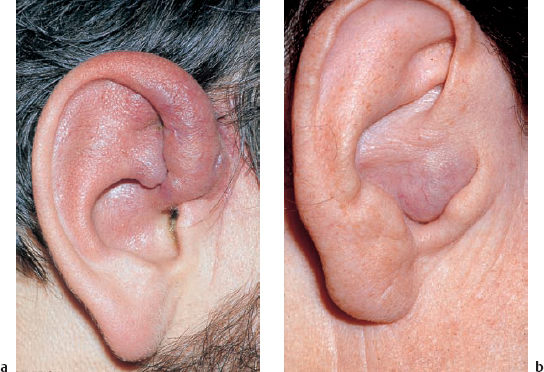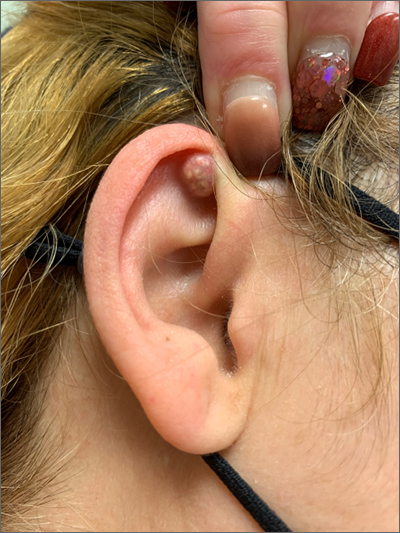Ear Tumors
What is an ear tumor?
An ear tumor is a mass or lump of abnormal cells that forms in the ear. Most ear tumors are benign or not cancerous. But some ear tumors are malignant (cancerous).
Ear tumors can form in any part of the ear, including the inner ear, middle ear and outer ear. They may affect your hearing.
What’s the difference between an ear cyst and an ear tumor?
Both cysts and tumors can cause a bump or lump in the ear.
- Cysts are small sacs that often contain fluid. They may also have solid material. Most cysts are not cancerous.
- Tumors are solid masses of tissue that may or may not be cancerous.
What are the types of benign (noncancerous) ear tumors?
Noncancerous ear tumors can block your ear canal, leading to earwax buildup. Types of benign ear tumors include:
- Acoustic neuromas (also called vestibular schwannomas) form on the vestibular nerve. This nerve in your inner ear connects to your brain.
- Adenomas are rare noncancerous tumors that develop in the middle ear.
- Cholesteatomas are sacs of fluid, air or skin cells that form behind the eardrum in the middle ear. They can lead to hearing loss if not treated.
- Glomus tympanicum paraganglioma affects the tympanic nerve. This nerve in the middle ear connects to the eardrum.
- Keloids are a type of fibrous scar tissue. They can form after an ear piercing or trauma to the outer ear.
- Osteomas and exostoses form on bones in the external ear canal (benign bone tumor).
- Sebaceous cysts contain skin cells and oil. They can develop in the ear canal, behind the ear or on the earlobe. They are also called epidermal inclusion cysts.
What are the types of malignant (cancerous) ear tumors?
Cancer can form inside or on the outside of your ear. Ear cancer is rare.
Most cancer that affects the ear is skin cancer. Skin cancer may first appear on the outer ear. Skin cancers that affect the ear include:
- Basal cell carcinoma.
- Melanoma.
- Squamous cell carcinoma.
Cancers that directly affect the middle or inner ear are even more uncommon. They include:
- Ceruminous adenoma forms in the cells that make earwax. This cancer doesn’t spread, but it can destroy parts of the ear canal.
- Rhabdomyosarcoma is a rare childhood cancer that affects muscle tissue. It may develop in the head or neck, including the middle ear.
Symptoms and Causes
What causes an ear tumor?
Tumors occur when your body makes new cells faster than usual. Sometimes, old, damaged cells don’t die off the way they should. Clumps of old and new cells group together, forming a tumor.
Cancerous tumors occur when the cells grow uncontrollably. Untreated, these malignant cells may spread to other locations in your body (metastatic cancer).
What are the risk factors for ear tumors?
People of all ages, including children, can get ear tumors. Factors that increase the chances of developing an ear tumor include:
- Chronic ear infections.
- Ear piercings.
- Inherited conditions, such as neurofibromatosis (NFS).
- Prior radiation exposure.
- Repeated exposure to cold water, such as from scuba diving (surfer’s ear).
- Smoking, including exposure to secondhand smoke.
What are the symptoms of an ear tumor?
Symptoms of an ear tumor vary depending on the tumor type and the part of the ear it affects. You may be able to feel a bump on the outer part of the ear.
Signs of an ear tumor include:
- Dizziness or balance problems.
- Ear bleeding or discharge.
- Ear pain.
- Headaches.
- Hearing loss.
- Nonhealing wound or sore.
- Skin discoloration, new moles or changes to a mole.
- Swollen lymph nodes.
- Tinnitus (ringing in the ear).
- Weak facial muscles.
How are ear tumors diagnosed?
Your healthcare provider may notice a cyst or tumor during a routine ear exam. Your provider may refer you to an audiologist (hearing specialist) for a hearing test. You will likely also see an ear, nose and throat doctor (an ENT or otolaryngologist) who specializes in ear disorders.
Your provider may perform a biopsy. This procedure removes the tumor or cells from the tumor. A pathologist (a doctor who studies diseases) examines the samples in a lab to make a diagnosis.
Because inner ear tumors are difficult to reach and biopsy, your provider may order a CT scan or MRI to learn more about an ear issue. In rare cases, you may need surgery to diagnose an ear tumor.
Management and Treatment
How are benign ear tumors treated?
Some noncancerous ear tumors don’t need treatment unless the tumor affects hearing or balance. Your provider monitors the tumor to keep an eye on its growth and any symptoms.
Healthcare providers often use radiosurgery (gamma knife surgery) to remove benign ear tumors like acoustic neuromas. This procedure directs high doses of radiation directly to the tumor. It’s not a surgical procedure.
To treat keloids, your healthcare provider may inject the tumor with a corticosteroid. Some keloids require surgical removal followed by radiation therapy.
How are malignant ear tumors treated?
Dermatologists (doctors who specialize in skin diseases) treat skin cancer on the outer ear. Treatment for cancerous ear tumors depends on the cancer type and location. Treatment might include:
- Mohs surgery to remove the cancerous skin cells.
- Radiation therapy, radiosurgery or chemotherapy to destroy cancer cells.
- Treatment for ceruminous adenoma tumor involves surgically removing the tumor. Your surgeon might also remove nearby lymph nodes.
Outlook / Prognosis
What are the complications of ear tumors?
Ear tumors, even ones that aren’t cancer, can cause hearing loss. Ear tumor treatments may also lead to hearing loss, balance problems and facial weakness.
What’s the prognosis for people with ear tumors?
Most people with ear tumors recover well after treatment. Some don’t need treatment at all. Skin cancer can come back (recur) and spread to other parts of your body. You’ll need regular skin exams to keep an eye out for returning cancer.
Living With
When should I call my doctor?
You should call your healthcare provider if you experience:
- Balance problems or dizziness.
- Ear bleeding, discharge or pain.
- Hearing loss.
- Ringing in the ears (tinnitus).
- Skin changes to the ear, including a new lump, mole or sore.
What questions should I ask my doctor?
You may want to ask your healthcare provider:
- Is the ear tumor malignant or benign?
- What type of ear tumor do I have?
- What is the best treatment for me?
- What are the treatment risks and side effects?
- Should I look out for signs of complications?

















